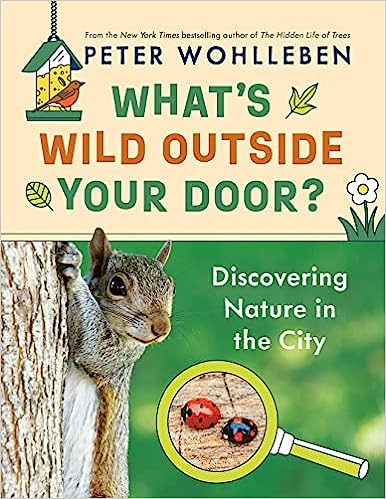What’s Wild Outside Your Door? Discovering Nature in the City

What’s Wild Outside Your Door? Discovering Nature in the City
Groundhogs are large ground squirrels. They not only dig burrows but also climb trees. They are also called whistle-pigs (after their warning calls) or woodchucks — although you do not chuck wood. Woodchuck is a mispronunciation of their Algonquin name, wucack, which means “digger.” If you live in southern Canada or the eastern states, you might see one of these chunky squirrels on the grassy margins of a highway. Keep your eyes peeled! (p. 23)
The introduction to What’s Wild Outside Your Door? Discovering Nature in the City explains the behind the scenes process of creating a book during the COVID restrictions that requires photographs of children doing activities and experiments. It is a charmingly honest discussion that sets this book in the historic context of a pandemic. Despite the challenging context, the message of hope is clear. Nature awaits you right outside your door.
One of the excellent features of the book is the explanation of what an Index is and how to use it. I have never seen a clearer explanation.
To use the index, find the topic you are interested in. The topics are in alphabetical order. The numbers after each topic are the page numbers that you can use to find the information. Page numbers in a range (as in 6-7) means that information is found on both pages 6 and 7. Page numbers in bold indicate a picture on the page. Sometimes similar information is listed under a different topic. You can find these if you see the words See also, and follow the cross-reference to the new topic. (p. 77)
The book is organized into five chapters: Getting Ready to Explore; Adventures in the City; Exploring Close to Home; What You Can Do to Help; and Nature All Around You. The Contents lists the Headings in each Chapter. Some chapters are longer than others, ranging from three sections in “What You Can Do to Help”, to eight sections in “Adventures in the City”.
Belle Wuthrich’s illustrations are a perfect complement to the information packed content, adding a touch of light whimsy. For example, the information about the food web is accompanied by illustrations of leaves with little nibbles by insects out of their edges.
The plants might not look perfect, but they will survive, and having the insects around will allow other creatures to survive as well. (p. 40)
Full-colour photos highlight plants and animals and also show students involved in some of the steps of the numerous activities included in most chapters.
Additional sidebars and text boxes enhance the text. “Supply List” boxes accompany every Activity. The Supply List with the instructions for creating a sundial even includes “An adult to drill a hole for you”. That’s a pretty comprehensive list!
“Dig Deeper” and “Insider Info” boxes provide additional information. Photo captions are imbedded in boxes in the photos.
One of the shortcomings of “What’s Wild Outside Your Door? Discovering Nature in the City” is the lack of common organizational tools, such as subheadings, and words in bold to draw attention to important or unfamiliar terms, or even leaving a space between paragraphs. Older students should have no trouble with the format of the text, but younger students may have more difficulties than necessary locating, organizing, and extracting information.
Another interesting omission is an ending to the book. For a book that clearly encourages and provides support for students to go out and explore nature in the city, the lack of a summary seems unusual. Perhaps a second edition will take advantage of the opportunity of emphasize the theme of living in and with nature in the city.
My most serious concern about the book is the first activity. In “How to Preserve What You Find”, readers are encouraged to go on a “plant-collecting expedition”. Care is taken to explain that “Rare plants are protected by law and you can’t pick them - not even in the city”, but this will send a confusing message to any students who have learned the credo, ‘Take only pictures, leave only footprints’.
I highly recommend What’s Wild Outside Your Door? Discovering Nature in the City. It has many more pluses than minuses and is sure to appeal to nature lovers, especially at the Grade 6-7 level.
Former teacher-librarian, Suzanne Pierson, tends her Little Free Library in Prince Edward County, Ontario, for the enjoyment of her friends and neighbours of all ages.
